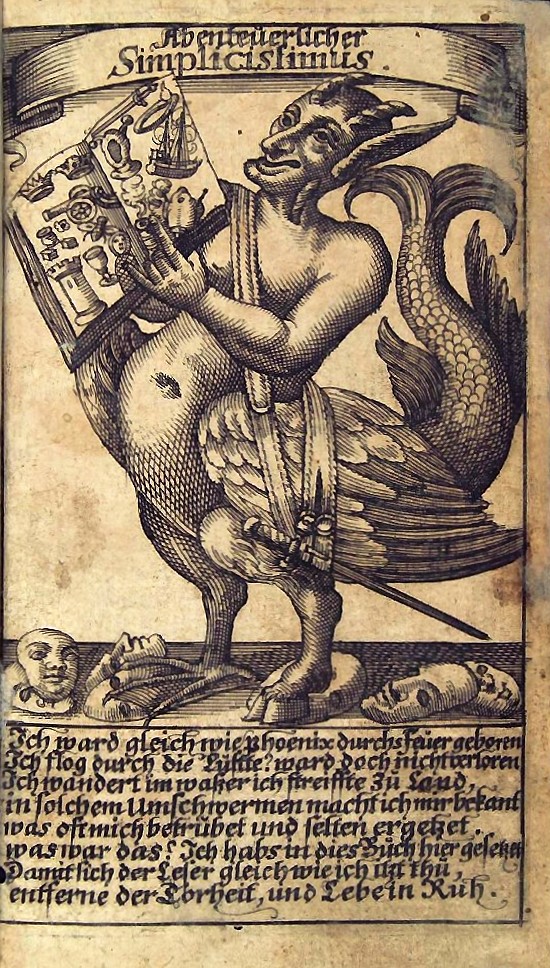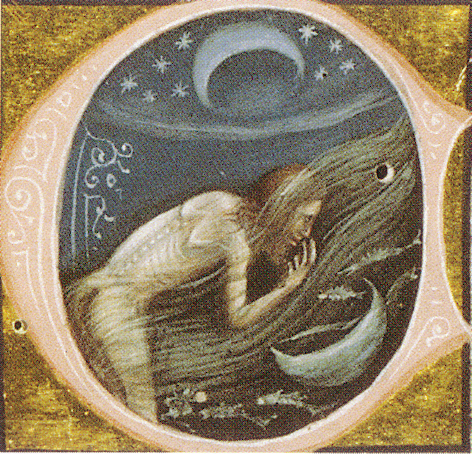|
Hans Jakob Christoffel Von Grimmelshausen
Hans Jakob Christoffel von Grimmelshausen (1621/22 – 17 August 1676) was a German author. He is best known for his 1669 picaresque novel ''Simplicius Simplicissimus'' (german: link=no, Der abenteuerliche Simplicissimus) and the accompanying ''Simplician Scriptures'' series. Early life Grimmelshausen was born at Gelnhausen. At the age of ten he was kidnapped by Hessian soldiery, and in their midst experienced military life in the Thirty Years' War. In 1639 he became a regular soldier in the Imperial Army. At the latest in the year 1644 he worked as a writer in a regiment's chancellery—from that year on documents by Hans Jakob Christoffel exist. At the close of the war, Grimmelshausen entered the service of Franz Egon von Fürstenberg, bishop of Strasbourg. In 1665, he was made magistrate (german: link=no, Schultheiß) at Renchen in Baden. On obtaining this appointment, he devoted himself to literary pursuits. Works Grimmelshausen's work is greatly influenced by ... [...More Info...] [...Related Items...] OR: [Wikipedia] [Google] [Baidu] |
Die Welt
''Die Welt'' ("The World") is a German national daily newspaper, published as a broadsheet by Axel Springer SE. ''Die Welt'' is the flagship newspaper of the Axel Springer publishing group. Its leading competitors are the ''Frankfurter Allgemeine Zeitung'', the ''Süddeutsche Zeitung'' and the ''Frankfurter Rundschau''. The modern paper takes a self-described "liberal cosmopolitan" position in editing, but it is generally considered to be conservative."The World from Berlin" '''', 28 December 2009."Divided ... [...More Info...] [...Related Items...] OR: [Wikipedia] [Google] [Baidu] |
Schultheiß
In medieval Germany, the ''Schultheiß'' () was the head of a municipality (akin to today's office of mayor), a ''Vogt'' or an executive official of the ruler. As official (''villicus'') it was his duty to order his assigned village or county (''villicatio'') to pay the taxes and perform the services due to the ruler. The name originates from this function: ''Schuld'' 'debt' + ''heißen'' 'to order'. Later, the title was also used for the head of a town (''Stadtschultheiß'') or village (''Dorfschultheiß''). The office held by a ''Schultheiß'' was called ''Scholtisei'', ''Scholtisse'' (around 1400), ''Schultessy'', ''Schultissīe'', ''Schultissei'' (15th century); Latinized forms: sculdasia (10th century), scultetia (13th century). The title first appears in the ''Edictum Rothari'' of 643 AD, where it is spelled in post-Roman Latin as ''sculdahis''. This title reappears again in the Lombard laws of Liutprand in 723 AD. The title was originally spelled in Old High German as ' ... [...More Info...] [...Related Items...] OR: [Wikipedia] [Google] [Baidu] |
Simplicissimus
:''Simplicissimus is also a name for the 1668 novel Der abenteuerliche Simplicissimus, Simplicius Simplicissimus and its protagonist.'' ''Simplicissimus'' () was a satire, satirical German language, German weekly magazine, headquartered in Munich, and founded by Albert Langen in April 1896. It continued publishing until 1967, interrupted by a hiatus from 1944–1954, and became a biweekly in 1964. It took its name from the protagonist of Hans Jakob Christoffel von Grimmelshausen, Grimmelshausen's 1668 novel ''Der Abenteuerliche Simplicissimus Teutsch''. Combining brash and politically daring content, with a bright, immediate, and surprisingly modern graphic style, ''Simplicissimus'' published the work of writers such as Thomas Mann and Rainer Maria Rilke. Its most reliable targets for caricature were stiff Prussian military figures, and rigid German social and class distinctions as seen from the more relaxed, liberal atmosphere of Munich. Contributors included Hermann Hesse, Gusta ... [...More Info...] [...Related Items...] OR: [Wikipedia] [Google] [Baidu] |
Mother Courage And Her Children
''Mother Courage and Her Children'' (german: Mutter Courage und ihre Kinder, links=no) is a play written in 1939 by the German dramatist and poet Bertolt Brecht (1898–1956), with significant contributions from Margarete Steffin. Four theatrical productions were produced in Switzerland and Germany from 1941 to 1952, the last three supervised and/or directed by Brecht, who had returned to East Germany from the United States. Several years after Brecht's death in 1956, the play was adapted as a German film, '' Mutter Courage und ihre Kinder'' (1961), starring Helene Weigel, Brecht's widow and a leading actress. ''Mother Courage'' is considered by some to be the greatest play of the 20th century, and perhaps also the greatest anti-war play of all time. Critic Brett D. Johnson points out, "Although numerous theatrical artists and scholars may share artistic director Oskar Eustis's opinion that Brecht's masterpiece is the greatest play of the twentieth century, productions of ''Mothe ... [...More Info...] [...Related Items...] OR: [Wikipedia] [Google] [Baidu] |
Bertolt Brecht
Eugen Berthold Friedrich Brecht (10 February 1898 – 14 August 1956), known professionally as Bertolt Brecht, was a German theatre practitioner, playwright, and poet. Coming of age during the Weimar Republic, he had his first successes as a playwright in Munich and moved to Berlin in 1924, where he wrote ''The Threepenny Opera'' with Kurt Weill and began a life-long collaboration with the composer Hanns Eisler. Immersed in Marxist thought during this period, he wrote didactic ''Lehrstücke'' and became a leading theoretician of epic theatre (which he later preferred to call "dialectical theatre") and the . During the Nazi Germany period, Brecht fled his home country, first to Scandinavia, and during World War II to the United States, where he was surveilled by the FBI. After the war he was subpoenaed by the House Un-American Activities Committee. Returning to East Berlin after the war, he established the theatre company Berliner Ensemble with his wife and long-time collaborator ... [...More Info...] [...Related Items...] OR: [Wikipedia] [Google] [Baidu] |
Grimmelshausen (Renchen) 7899
Grimmelshausen is a municipality in the district of Hildburghausen, in Thuringia, Germany Germany,, officially the Federal Republic of Germany, is a country in Central Europe. It is the second most populous country in Europe after Russia, and the most populous member state of the European Union. Germany is situated betwe .... References Municipalities in Thuringia Hildburghausen (district) Duchy of Saxe-Meiningen {{Hildburghausen-geo-stub ... [...More Info...] [...Related Items...] OR: [Wikipedia] [Google] [Baidu] |
Robinsonade
Robinsonade () is a literary genre that takes its name from the 1719 novel ''Robinson Crusoe'' by Daniel Defoe. The success of this novel spawned so many imitations that its name was used to define a genre, which is sometimes described simply as a "desert island story" or a "castaway narrative". In a robinsonade, the protagonist is suddenly separated from civilization, usually by being shipwrecked or marooned on a secluded and uninhabited island. They must improvise the means of their survival from the limited resources at hand. The word "robinsonade" was coined by the German writer Johann Gottfried Schnabel in the Preface of his 1731 work '' Die Insel Felsenburg'' (''The Island Stronghold''). It is often viewed as a subgenre of survivalist fiction. Already in Simplicius Simplicissimus (1668) by Hans Jakob Christoffel von Grimmelshausen the shipwrecked protagonist lives alone on an island. Themes In the view of Irish novelist James Joyce, Robinson Crusoe is a symbol of the Bri ... [...More Info...] [...Related Items...] OR: [Wikipedia] [Google] [Baidu] |
Picaresque
The picaresque novel (Spanish: ''picaresca'', from ''pícaro'', for " rogue" or "rascal") is a genre of prose fiction. It depicts the adventures of a roguish, but "appealing hero", usually of low social class, who lives by his wits in a corrupt society. Picaresque novels typically adopt a realistic style. There are often some elements of comedy and satire. While the term "picaresque novel" was only coined in 1810, the picaresque novel originated in Imperial Rome during the 1st-2nd century CE, in particular with works such as the Satyricon of Petronius and later, and more particularly with authors such as Apuleius in Roman Numidia. It would see a revival in Spain during the Spanish Golden Age in 1554. Early Spanish contributors included Mateo Alemán and Francisco de Quevedo, who were influenced in particular by Apuleius' 2nd century work. Other notable ancient influences of the modern picaresque genre include Roman playwrights such as Plautus and Terence. The Golden Ass of Apu ... [...More Info...] [...Related Items...] OR: [Wikipedia] [Google] [Baidu] |
Modern Language Review
''Modern Language Review'' is the journal of the Modern Humanities Research Association ( MHRA). It is one of the oldest journals in the field of modern languages. Founded in 1905, it has published more than 3,000 articles and 20,000 book reviews. ''Modern Language Review'' is published four times a year (in January, April, July and October). All articles are in English and their range covers the following fields: * English (including United States and the Commonwealth) * French (including Francophone Africa and Canada) * Germanic (including Dutch and Scandinavian) * Hispanic (including Latin-American, Portuguese, Catalan, and Galician) * Italian * Slavonic and East European Studies * General Studies (including linguistics, comparative literature, and critical theory) History The first issue was published in October 1905 with John G. Robertson as the founding editor-in-chief. When Robertson died in 1933, he was replaced by Charles Jasper Sisson. Sources [...More Info...] [...Related Items...] OR: [Wikipedia] [Google] [Baidu] |
The Man In The Moone
''The Man in the Moone'' is a book by the English Divine (noun), divine and Church of England bishop Francis Godwin (1562–1633), describing a "voyage of utopian discovery". Long considered to be one of his early works, it is now generally thought to have been written in the late 1620s. It was first published posthumously in 1638 under the pseudonym of Domingo Gonsales. The work is notable for its role in what was called the "new astronomy", the branch of astronomy influenced especially by Nicolaus Copernicus. Although Copernicus is the only astronomer mentioned by name, the book also draws on the theories of Johannes Kepler and William Gilbert (astronomer), William Gilbert. Godwin's astronomical theories were greatly influenced by Galileo Galilei's ''Sidereus Nuncius'' (1610), but unlike Galileo, Godwin proposes that the dark spots on the Moon are seas, one of many parallels with Kepler's ''Somnium (novel), Somnium sive opus posthumum de astronomia lunari'' of 1634. The story ... [...More Info...] [...Related Items...] OR: [Wikipedia] [Google] [Baidu] |
Francis Godwin
Francis Godwin (1562–1633) was an English historian, science fiction author, Anglicanism#Anglican divines, divine, Bishop of Llandaff and Bishop of Hereford, of Hereford. Life He was the son of Thomas Godwin (bishop), Thomas Godwin, Bishop of Bath and Wells, born at Hannington, Northamptonshire. He was the great uncle of the writer Jonathan Swift. He was elected student of Christ Church, Oxford, in 1578, took his bachelor's degree in 1580, and that of master in 1583. After holding two Somerset livings he was in 1587 appointed subdean of Exeter. In 1590 he accompanied William Camden on an antiquarian tour through Wales. He was created bachelor of divinity in 1593, and doctor in 1595. In 1601 he published his ''Catalogue of the Bishops of England since the first planting of the Christian Religion in this Island'', a work which procured him in the same year the diocese of Llandaff. A second edition appeared in 1615, and in 1616 he published an edition in Latin with a dedication t ... [...More Info...] [...Related Items...] OR: [Wikipedia] [Google] [Baidu] |
Jean Baudoin (translator)
Jean Baudoin (1590–1650), born in the Vivarais region, was a French translator, notable as the first French translator of Torquato Tasso's ''La Gerusalemme liberata'' and as an early member of the ''Académie française'', to which he was elected before 13 March 1634. He died of hunger and cold in 1650, and was succeeded at the Académie by François Charpentier. Baudoin translated from English as well; his translation of Francis Godwin's ''The Man in the Moone'' first appeared in 1648 and went through four subsequent printings. His translation was also the basis for the German translation. Baudoin translated Cesare Ripa's ''Iconologia'' of 1593 into French and published it in Paris in 1636 under the title ''Iconologie''.Olga Vassilieva-Codognet, ''À la recherche des généalogies effigionaires de princes: Series of Retrospective Dynastic Portraits and the Social Implications of True Likeness (Antwerp, ca. 1600)'', p. 102-105 The ''Iconologia'' of Ripa was a highly influentia ... [...More Info...] [...Related Items...] OR: [Wikipedia] [Google] [Baidu] |



_1988%2C_MiNr_Block_091.jpg)


